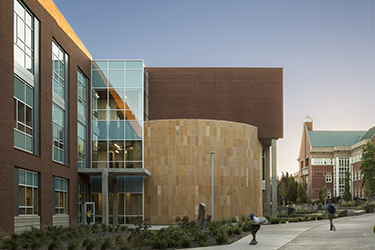|
Subscribe / Renew |
|
|
Contact Us |
|
| ► Subscribe to our Free Weekly Newsletter | |
| home | Welcome, sign in or click here to subscribe. | login |
Construction
| |
 |
October 26, 2023
Creating inclusive restrooms through design
Integrus

Larsen
|

Campanella
|
A fully inclusive community welcomes people regardless of age, ability, income, or ethnic background. Architecture plays a foundational role in the spatial framework that either facilitates or inhibits inclusion. And the work of designers of public spaces encompasses all facets of a building— from overall aesthetics to space planning and even utilitarian functions like restrooms.
Public restrooms have long played a role in the gravitational shift of societal norms, with bathroom design central to society’s evolution toward inclusivity. Recently, attention has been given to the role public restrooms have in addressing this basic construct within our communities, especially higher education campuses.
When designed with intentionality, these spaces can have a great impact on care and belonging. It’s worth setting aside preconceptions to look at restrooms a bit differently — and to get comfortable with being uncomfortable.
Shifting societal norms reflected in public restrooms
Looking back, it appears as if the public restroom has long marked cultural shifts in society’s history. The Romans had male-only communal latrines. Increased understanding of hygiene and the need for drainage led to infrastructure surrounding sewage removal.
The 1851 Great Exhibition in London featured single-use, male-only ‘monkey closets’ introducing the notion of privacy. Women entering the industrial factory workforce in the late 1880’s compelled the addition of ‘Ladies Rooms.’
The fight to remove segregated bathrooms was heightened during the 1960’s Civil Rights movement, and the demand for accessible restrooms resulted in the 1990 Americans with Disabilities Act. Understanding these markers helps us to realize how far we have come.
Addressing disparate user needs through design
What comes to mind when hearing the term ‘inclusive restroom?’ Diverse cultural and demographic backgrounds are often not fully considered when visualizing and contextualizing these spaces, and achieving this becomes increasingly complex with diverse user groups. It’s easy to be hyper-focused on one lens of the conversation.
Despite efforts to simplify approaches, the design of these spaces remains complex and multi-faceted. The danger is skewing needs toward one affinity group, thereby creating unintentional inequities, and excluding others’ needs. We are only just beginning to understand that restroom considerations are more than just male and female, black or white, able or disabled.
We have inevitably bumped into our probable next societal shift, with restrooms once again marking the times. Regardless of strong feelings surrounding the choice to provide (or not provide) inclusive restrooms, architects are positioned to address user needs through design, and to educate decision makers with more understanding integrated into our processes.
When designed with empathy, inclusive restrooms address disparate needs and impart a sense of belonging in meeting the needs of all, improve efficiency, reduce wait times, tackle safety concerns, gracefully address religious and social constructs.
Broadening the concept of accessibility
While the initial point of reference with restrooms is historically gender-based, inclusive design centers on universal acceptance and inclusiveness for ALL. This necessary shift in thinking must conclude inclusive restrooms are more than gender related, or a gender identity issue.
Inclusive restrooms are without gender designation, accessible to everyone, designed for privacy, safe and welcoming where people do not face discrimination or harassment. They feature inclusive amenities including both types of ‘receptacles’ and family-friendly assists like nursing areas and changing tables.
Stepping outside traditional views to explore the experience of restrooms through diverse lenses enables a deeper understanding of how different restroom models are experienced. Strategies to develop empathy include stepping out of one’s comfort zone to examine biases, walk in other’s shoes and maintain respect.
Inclusive restroom design extends to actual physical space when addressing inherent inefficiencies, disparity in locations, differences in wait times, variation of stall configurations, and the idea people around us don’t feel comfortable entering a public restroom for fear of ostracization, or lack of safety. Related considerations include cost, maintenance, adaptability, safety, and privacy.
This clearly comes with a cost, primarily a cost to retrofit and replace. This can include more individualized ventilation for each stall, more walls as opposed to connected stalls. In turn, it may streamline daily maintenance for economies of scale providing long term savings.
Currently, international plumbing codes are not yet mandated, although amendments to the International Plumbing Code allows for installation of all-gender, multiuser restrooms in public buildings, and requires single-user restrooms display signage indicating they are available to all users.
Maintaining adaptability and increasing awareness
There are tools to aid in discussions around restrooms. A community-based process of empathy can be applied to build awareness around disparate perspectives and needs. These include an interactive process to develop increased empathy, identifying perspectives that drive restroom design, and common process barriers hindering a sense of belonging while understanding opportunities and constraints impacting the design, construction, maintenance, and operations.
As Jeremy Sutton says in Positive Psychology, “If we are to solve problems at an individual level and gain a greater understanding of the issues humanity faces, we must develop compassion and empathy to make decisions that meet the need of everyone, not just ourselves.”
Not only is legislation and adoption for restrooms teetering on a shift, but acceptance by those utilizing these new forms of restroom is still evolving and in a constant feedback loop of what is and isn’t working.
The key is to stay adaptable so facilities can remain current to code, but equally important, meet the needs of those using the restrooms in the most appropriate and meaningful ways possible.
As the character or restrooms transition away from models that are decades old, it is important that new restroom conditions are clear and obvious. Change is hard and restrooms are a private space where the unknown can cause great discomfort and even fear. Creating consistent conditions across different buildings or restroom pods, when possible, removes the guesswork.
Improving the human experience on campus
There is no one solution or restroom typology that will meet the needs of everyone in public buildings. With diverse stakeholders in ability, age, culture, gender, and more it is critical to provide choices wherever possible for the perceived and real benefits that different restrooms offer.
In our work at Central Washington University, preliminary design was rooted in empathy and understanding human needs when crafting inclusive restroom concepts for their Center for Cultural Innovation.
Typically, restrooms are a hidden feature, but after extensive engagement sessions, students unequivocally wanted inclusive restrooms off the main building entrance to make this functional space a beacon of inclusivity. They wanted people to know loud and clear, that this was a place where ALL are welcomed.
At Lewis & Clark College in Portland, Ore., our design for diversity and more ADA accessibility in the redesign of the backstage theater dressing rooms included creating inclusive restrooms that improve the human experience for everyone.
It seems students are on the leading edge of how we can best approach society’s next cultural shift through architecture, and we look forward to our role in advancing a sense of belonging in all spaces.
Kandis Larsen is a principal at Integrus working on projects in the public realm, emphasizing higher education. Tina Campanella is a senior associate and marketing specialist leading higher education-focused business development at Integrus.
Other Stories:
- Community colleges provide essential student support with affordable on-campus housing
- Coming together to build a catalyst project for WSU’s new engineering and architecture district
- Innovating student housing with mass timber and rain gardens
- Designing for urban student living
- Enhancing the student experience through Living Design
- Finding the balance in housing density and student well-being
- Going up: Seattle’s towering new vision for student housing
- Going up: Seattle’s towering new vision for student housing
- Innovation Hall breaks new ground in partnerships and processes



